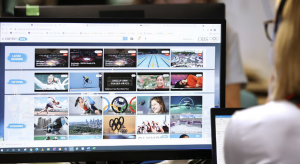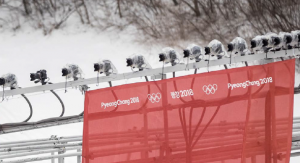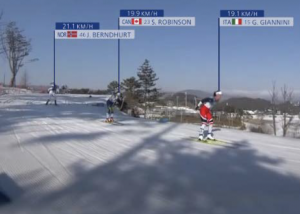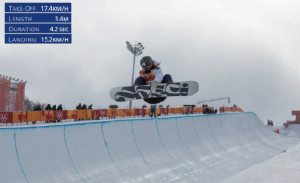Beijing 2022: OBS Content+ Helps Digital Efforts; Next-Gen Data Analysis Improves
Every Olympics Games sees an increase in the power that digital distribution via social media and OTT has over workflows and production demands. Karen Mullins, OBS, director of production management, says that to help RHBs provide this dynamic environment in which viewers can experience the content on their own terms and stay ahead of the curve, OBS has created a wide range of services for the digital arena.

Content+ makes it easier than ever for Olympic rights holders to find the right clip for social and digital distribution.
“One of these services designed primarily for digital is Content+, which is a cloud-based solution offering short-form content from across the Games, as well as all live content produced by OBS, that can be easily shared across all platforms,” she says. “OBS has dedicated crews to generate behind-the-scenes content from the competition venues, the Olympic Villages and some locations outside the Closed Loop. OBS also generates content with smartphones, providing short video clips from back-of-house athlete areas that will be available to RHBs’ social media teams almost instantly.”
She says that between 7,000 and 8,000 clips are expected to be produced to help enhance and supplement RHB coverage. Distributed through a user-friendly web portal, in three different resolutions, this short-form content will be accessible by the RHBs’ digital and social media teams from any location in the world.
“For Beijing 2022, OBS has built a new integrated and agile editing functionality, which allows RHBs to create sub-clips from any content, enabling them to craft their video content with an optimal length for each platform,” she adds. “Further, OBS produced fast turnaround clips from all sports, offering broadcasters access to highlights content quickly and effortlessly. OBS will create more than 340 sports highlights clips that RHB digital teams will be able to push on social media in a timely manner.”
Reliable and high-quality live web streaming and on-demand video end-to-end solutions will also be provided to support the broadcasters’ multi-platform strategies through the OVP suite.
Next-Gen Graphics and Analysis
The Beijing Games also saw OBS improve the quality of production tools that create a more immersive broadcast experience. Kim Erdahl, OBS, senior graphics manager, says 10 Multi-Camera Replay Systems (up from 4 in 2018) to provide replays of the action from a multi-angle perspective, enabling fans to have an up-close look at the action, from various angles, and experience Olympic winter sports in more engaging ways, have been expanded.

The use of multi-camera replays has increased to 10 systems from only 4 in PyeongChang.
Relying on a myriad of high-speed 4K cameras, Multi-Camera Replay technology offers the ability to move around the action at any given point of time and watch it from a variety of angles, in near real time. “Furthermore, the replay can be paused at different junctures in the motion,” she says. “The effect is similar to action scenes in the movie “The Matrix” where the camera seems to pan 360 degrees around the main actor while he floated in mid-air or dodged a bullet.
“For instance, at the Zhangjiakou National Ski Jumping Centre, such a camera system will be installed in proximity to the end of the take-off ramp to capture the first seconds of the ski jumper’s flight,” she says. “The multi-camera replays will allow viewers to have a better understanding of how athletes use their body to control the jump, having the possibility to see it from multiple angles.”
The total number of 4K cameras varies from one venue to the other (up to 120 cameras at the Ice Hockey venues). They will be placed in selected locations for optimal viewing without obstructions. Spaced at regular intervals on a rig structure, each camera is mounted on a robotic platform capable of precisely panning and tilting the camera in any direction. The camera’s zoom, focus and the platform’s pan and tilt capabilities are controlled from the production unit. For each replay, a single operator selects the point where the motion is frozen and can manipulate the replay from side to side around the athlete, as well as zoom in without losing resolution (thanks to the 4K resolution).
Since the system simply stitches together these feeds and does not have to virtually create filler frames, no rendering is required, allowing Multi-Camera Replay clips to be ready in under five seconds. For curling and speed skating, OBS has partnered with Worldwide TOP Partner Alibaba to utilize its leading-edge cloud solution to seamlessly deliver the multi-camera replays. It is the first time that OBS will rely on a cloud-based workflow for replays. All frames captured by the array of cameras installed at these two venues will be sent to an edge server and be reconstructed in Alibaba Cloud to generate the replay clips. Those will be up-converted to 4K in the cloud before being sent back to the production unit in the venue compound.

2D image tracking is making a difference with cover of cross-country and biathalon events at the Olympics.
The use of 2D image tracking, successfully introduced at Tokyo 2020, (for the coverage of athletics marathon and race walks, cycling road and mountain bike, aquatics marathon swimming, triathlon, canoe sprint and rowing) is also in use this year. OBS will use the 2D image tracking (also referred to as athlete ‘pinning’) technology again in Beijing, for all the biathlon and crosscountry skiing events. It will help commentators and viewers to keep track of the position of the athletes throughout the event in real-time.
“Compared to other athlete live tracking solutions that rely on GPS positioning or wireless equipment, 2D image tracking is based on advanced image processing technology that allows motion tracking,” says Erdahl. “A ‘patch’ (a square) is defined on selected video frames in order to identify each of the athletes. The computer then creates a ‘label’ that is attached to each of the identified athletes and that will be maintained even as the image changes. This captured data is then made available to a graphics rendering platform for on-screen presentation to the viewers, enabling them to know the exact location of the athletes/groups.”
Additional data captured using more traditional GPS positioning can be combined with the ‘labels’ to identify athletes, their speed, distance to finish or relative position to the leader.
Live speed measurement during alpine skiing has also made a big difference for viewers. OBS has partnered with Worldwide TOP Partner OMEGA to extend the live speed measurement for the downhill events across the fastest sections of the course, allowing worldwide audiences to get an insight into the astonishing speeds Olympic skiers achieve.
“Speed measurement in the coverage of alpine skiing events was introduced as part of the TV graphics at Sochi 2014,” says Erdahl. “However, until now, the speed was measured from a very specific position and limited to only snapshots, or just a few seconds of data. This was due to the limited sensor coverage available.”
OMEGA has deployed a multitude of newly developed antennae with increased reception capacity that allow for the capture of more data throughout a much larger portion of the downhill course. The use of such technology will also guarantee an overall better speed measurement in terms of accuracy and frequency of updates.

OMEGA is powering next-gen stats related to height at events like the halfpipe.
In collaboration with OMEGA, OBS is also offering additional ‘Jump’ data for selected sports/ disciplines to commentators, providing them with new levels of jump analysis.
“Incredible motion sensors and computer vision analysis will help capture real-time data such as speed, height, length, duration, angles of skis,” says Erdahl.
And, lastly, OMEGA has also played a role with sports analysis for Curling by introducing visualization of stone trajectories and new measurements.
“A virtual overhead camera will allow unimpeded analysis of stone position, contact points, trajectory and distance between stones
for one sheet at a time,” says Erdahl.
